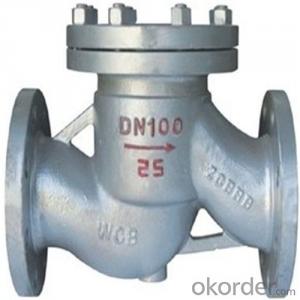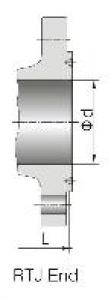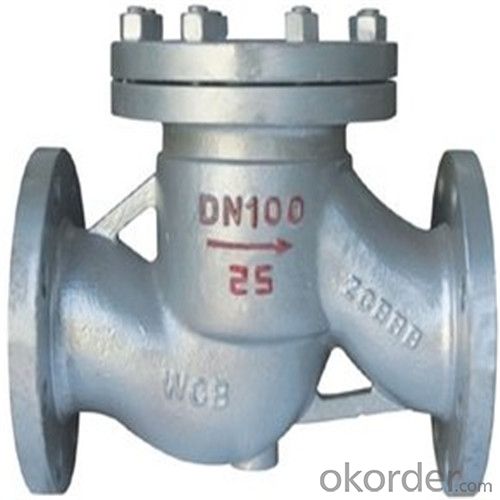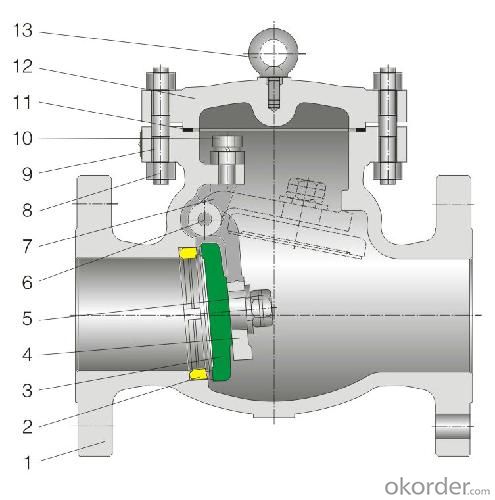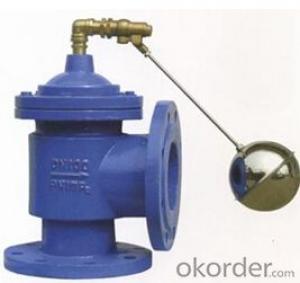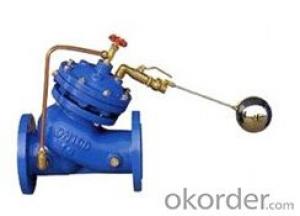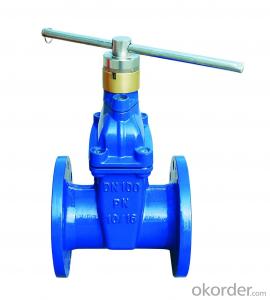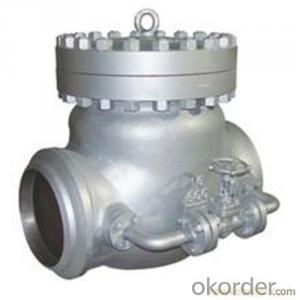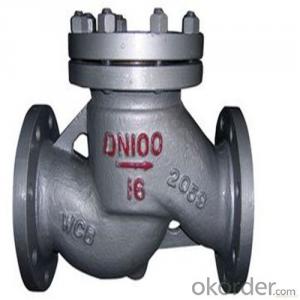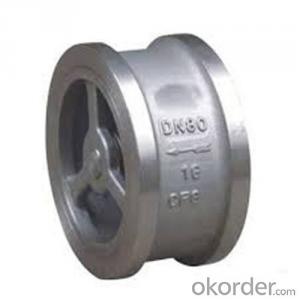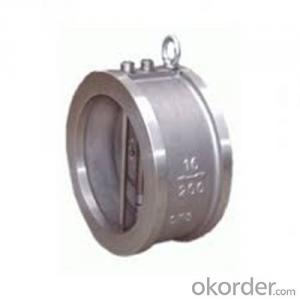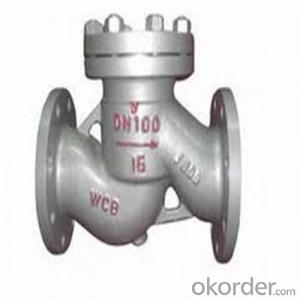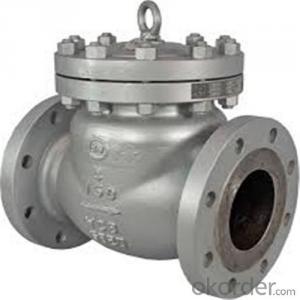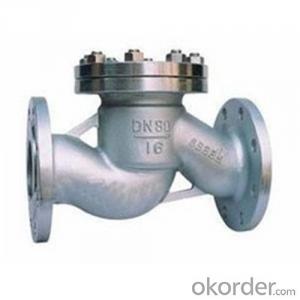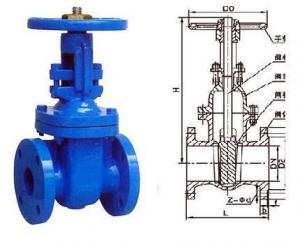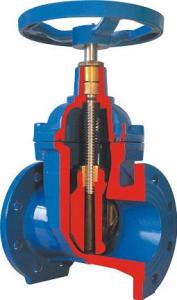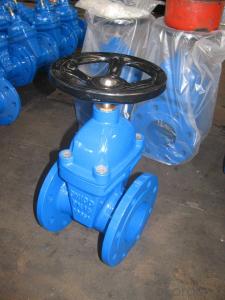API Cast Steel Lift Check Valve A351-CF8 Body Material
- Loading Port:
- Shanghai
- Payment Terms:
- TT OR LC
- Min Order Qty:
- 10 pc
- Supply Capability:
- 100 pc/month
OKorder Service Pledge
OKorder Financial Service
You Might Also Like
API Cast Steel Lift Check Valve 150 Class
The features of Cast Steel Lift Check Valve
Bolted Bonnet;Swing and lift disc;Metallic seating surfaces.
Body and Bonnet Connection of Cast Steel Lift Check Valve:
The body and bonnet of Class150~Class900 check valves are usually with studs and nuts.And the body and bonnet of Class1500~Class2500 check valves are usually of pressurized seal design.
Body-To-Bonnet Joint of Cast Steel Lift Check Valve:
Stainless steel + flesible graphite wounded gasket is used for Class 150 and Class 300 check valve;Stainless steel + flexible graphite wounded gasket is used for Class 600 check valve,and joint gasket is also optional for Class 600 check valve;Ring joint gasket is used for Class900 check valve;Pressurized seal design is used for Class 1500~Class 2500 check valves.
Seat of Cast Steel Lift Check Valve:
For carbon steel check valve,the seat is usually forged steel.The sealing surface of the seat is spray welded with hard alloy specified by the customer.Renewable threaded seat is used for NPS<10 check="" valves="" and="" welded="" on="" seat="" can="" be="" also="" optional="" if="" being="" requested="" by="" the="" customer.welded="" is="" used="" for="" nps="">12 crbon steel gate valves .Forstainless steel check valve,integral seat is usually adopted ,or to weld hard alloy directly integrally.Threaded or welded on seat is also optional for stainless steel check valve if being requested by the customer.
Parameter of Cast Steel Check Valve:
Standard Criteria | ASME/ANSI/API customize |
Pressure Rating | 150 Class 300 Class 600 Class 900 Class 1500 Class 2500 Class customize |
Valve Size | 50 mm 65 mm 80 mm 100 mm 125 mm 150 mm 200 mm 250 mm 300 mm 350 mm 400 mm 450 mm 500 mm 600 mm 650 mm 700 mm 750 mm |
2 inch 2.5 inch 3 inch 4 inch 5 inch 6 inch 8 inch 10 inch 12 inch 14 inch 16 inch 18 inch 20 inch 24 inch 26 inch 28 inch 30 inch customize | |
Actuator | Automatic customize |
Connection | Butt Welding Flange RF Flange RTJ customize |
1-Body Material | A216 WCB A351-CF8 A351-CF8M customize |
2-Seat ring | A351-CF8 A351-CF8M A105+13Cr Tool Steel+A105 customize |
3-Disc | Tool Steel+A216 WCB A351-CF8M A351-CF8 A216 WCB+13Cr customize |
4-Arm | A351-CF8 A216 WCB A351-CF8M customize |
5-Nut | A194 8M A194-8 A194 2H customize |
6-Arm pin | A182-F6a A182-F316 A182-F304 customize |
7-Yoke | A351-CF8 A351-CF8M A216 WCB customize |
8-Bonnet nut | A194 8M A194-8 A194 2H customize |
9-Bonnet bolt | A193-B8 A193-B8M A193-B7 customize |
10-Bolt | A193-B7 A193-B8 A193-B8M customize |
11-Gasket | graphite+304 graphite+316 customize |
12-Bonnet | A216 WCB A351-CF8M A351-CF8 customize |
13-Eye bolt | A181 customize |
Design Standard | API 6D BS 1868 customize |
Connection Standard | API 605 ASME B 16.25-2007 ASME B 16.47A ASME B 16.47B ASME B 16.5 MSS SP-44 customize |
Test Standard | API 598 API 6D customize |
Face to Face | ASME B 16.10 customize |
Pressure-temperature ratings | ASME B 16.34-2004 customize |
Wall thickness dimension | API 600 BS 1868 |
FAQ of Cast Steel Check Valve:
Q1:I can’t find the type of steel check valve which I need. what can I do?
The chart above only lists out some common composition of steel check valve parts.We may provide other different parts material composition according to the customer's request or the actual valve working condition.
Q2:Which certification do your products pass?
Our products are in accordance with ISO 9001、ISO 14001、API 6A、API 6D、TS CE、API607/6FA/BS6755.
- Q: Hi. I am planning to install new kitchen faucet and noticed that there are two shut off valves under the sink. One of them is badly rusted and needs to be replaced. I noticed that it is connected to three pipes (one of which is kitchen faucet). The other is clearly water coming in. What is the third one connected to wall? Also how should I go about replacing this? Anything that I should be careful of?
- Double Shut Off Valve Dishwasher
- Q: I know what a valve is, but I would like to know what an actuator does?
- It opens and closes the valve without manually doing it. They may be as simple as a solenoid opening to refill the ice maker tray or proportioning control valves with the ability to change the flow by tiny increments to achieve a desirable result.
- Q: Situation: The males in my family have mitral valve prolapse, while I do not.If anyone could answer some of the following questions, it would be amazing! Thank you so much!1. Is this an X or Y chromosome disease? (I thought since it was just guys, it'd b Y)2. If so (or not), is there any reason why I don't have it?Thanks again! (:
- I think it could have just skipped you in the generation of it all, it is not always hereditary to every generational child sometimes it will skip a generation and may catch your children when you have some. I know thats not the best news but most of the time thats how it works.
- Q: Com wires attached to com and all individual valve wires are attached. The valves work manually( turn on by hand), I open the valve to allow the box to take over and the sprinklers run. Is this just residual water in the lines??
- I would test the leads inside the control box first... You will have to run the controls manually to troubleshoot the problem. Get a voltage meter to test for the 24 volts at the transformer connections inside the box... If you do not have the 24 volts then the problem will be the transformer. If you have the correct voltage from the transformer then you can test each of the station terminals to common. Test through each station to see if you have 24 volts at each station terminal, but you may have to remove the wires off to test. If you do not have power coming from each station… then the problem will be the rain bird control. The next step would be testing the wires… If you reconnect the wires… test just prior at each valve location to see if you have the 24 volts between the common and each station wire… if you can prove out that there is 24 volts at this location then you’re down to the final testing. Reconnect the valves – one side to the common and the other to each station wire… Getting the power (24v) to the valve should have cleared your problem. Good Luck… Running the valves manually will not affect the operation of the rainbird control... but with my rainbird valves.. you can shut off the valves completely and disable the electrical controls of the valve... make sure that you have not closed the valve off manually preventing the electrical side... a problem with rainbird controls. This does not have anything to do with residual water in the lines... I would test this side first before you get into the electrical side... could save you a lot of time.
- Q: The check engine warning light came on in my car, i went to pump gas and try to start but it wouldn't start. I went to the dealership to let them check up, and they said the problem was the purge valve, it leaked. What is a purge valve and what does it do? Is it common for purge valve to go bad?
- i would guess on avg 100K miles. But hey, my girlfriend has a 2006 altima and the starter went bust. My 98 acura still has it's original starter (honda uses great oem parts). things go depending on driving conditions and what we in the auto parts stores call flukes. Like a 2007 pontiac that needs a new ignition coil. That's why aftermarket companies continue to make parts for cars. no one wants to go to the dealer.
- Q: My washing machine had hot and cold water, but was leaking. I changed the inlet valve which stopped the leak, but now I have no hot water. When I put the setting on warm, the cold water runs for a bit. Then stops and no hot water comes. Any help?
- I suspect the leaking valve that was replaced was your washer's solenoid valve. Did you remember to turn the hot water supply valve on after you finished? That is the valve, next to the cold water supply valve, on/at the wall behind the washer. There are rubber hoses coming from those valves to the solenoid valves on your washer. If you forgot to turn it back on after replacing the leaking valve you'll get no water. If you turn off both the hot and cold supply valves on the wall you should be able to remove the rubber hoses right where they connect to the machine and check the water flow by directing them into a bucket or pan while you open the supply vales. If you have good pressure and flow make sure there is no debris clogging the screen, just inside there the hose connects to your machine. These can get blocked where the water won't pass or runs very slow. Sometimes it pays to check the simplest causes first. Good Luck. SS.
- Q: My car (RWD) has vacuum leak and has the code PO171/PO174. I find some engine oil at the bolt well of the valve cover on the bank 2 side. Can the vacuum leak come from the valve cover? What is the main function of the valve cover? Thanks.
- Valves and the cam or rocker arm assemblies on top of the cylinder heads are lubricated by engine oil that is pumped or splashes up from the crankcase. Valve covers just contain the oil and keep dirt out of the engine. Vacuum comes from the intake manifold, and is routed to various locations through small flexible rubber hoses. A vacuum leak is probably from one of those small rubber hoses that has cracked or come loose.
- Q: hi can any one help me ajust the valves on my 1981 xs650 witch side do i start on and any help will be great i was told it is not hard i an 72 years old and i do all my own tune ups but i forget thanks pop.
- Remove both spark plugs. Remove all 4 valve inspection covers. Remove the Generator cover (L crankcase cover, round, 2 screws). It doesn't matter which side you start on. Turn the crankshaft in the direction the engine runs. Depending on which cylinder you're working on, watch that intake valve. When the rocker arm pushes it down, then comes back up, the piston is then moving up on the compression stroke. Continue turning until the piston is at top dead center. You can line up the T mark on the flywheel with the pointer, or look into the spark plug hole to see when the piston is at the top. Adjust the valve clearance for the intake exhaust valves on that cylinder. Repeat for the 2nd cylinder.
- Q: I have a problem with standing water that keeps puddling up and never drains under where my valves are located for my sprinklers. What do I do? Should I just put 3/4 drain rock on top? Please help?
- Sounds to me, like you have one of two things happening. Either you have a leak, which needs to be fixed. Or the valve box is in a low area where the water drains to... Turn on the water and watch the valves.. you might be able to see where the water is coming from. It may be as simple as tightening down the valve screws, or you may need to turn off the water at the main and repair or replace it. If the water is draining there or the leak isn't all that terrible the only way drain rock would help is if you were to dig underneath the valve a little, and to replace what you dig out with rock... Just make sure you can still access everything when you are finished. Good Luck!
- Q: I am trying to bench bleed my master cylinder on a 94 altima...the directions state to attach the bleeding hoses to the outlet valves?? I haver four valves that merely state front or rear??
- All hot water heaters have what they call Anode Rods For more than 60 years, it has been used as a key part of the rust protection of a tank. The rods are made of magnesium or aluminum that's formed around a steel core wire and is screwed into the top of the tank. A lot of the times they are on the hot water outlet. You should have a dielectric union separating the galvanized pipe on the top of the water heater from the copper pipe for your house supply. You should be able to remove the anode rod from the tank and get a replacement from your local plumbing supply store. Most likely the sediment/ hard water deposits have deteriorated the rod and have caused corrosive deposits to clog your lines.
Send your message to us
API Cast Steel Lift Check Valve A351-CF8 Body Material
- Loading Port:
- Shanghai
- Payment Terms:
- TT OR LC
- Min Order Qty:
- 10 pc
- Supply Capability:
- 100 pc/month
OKorder Service Pledge
OKorder Financial Service
Similar products
Hot products
Hot Searches
Related keywords
